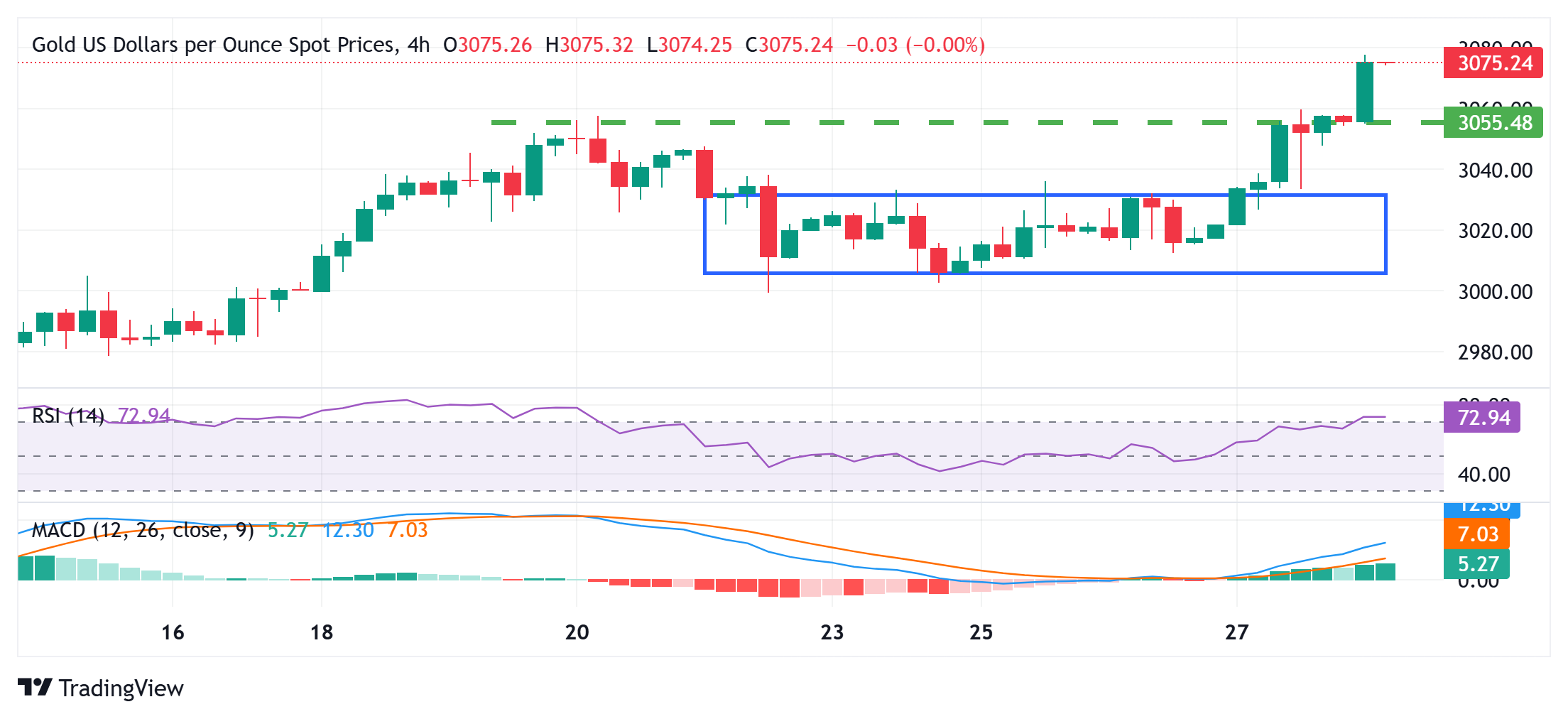Gold price buying remains unabated; fresh record high and counting ahead of US PCE data
- Gold price continues to attract safe-haven flows amid rising trade tensions.
- Fed rate cut bets offset a modest USD strength and support the XAU/USD pair.
- Traders now look to the US PCE Price Index for some meaningful impetus.
Gold price (XAU/USD) retains its bullish bias through the first half of the European session on Friday and touches a fresh all-time peak, around the $3,086 region in the last hour. The global risk sentiment continues to be undermined by worries over US President Donald Trump's auto tariffs announced on Wednesday, the uncertainty about impending reciprocal tariffs next week, and their effect on the global economy. The anti-risk flow is evident from a generally weaker tone around the equity markets, which, in turn, is seen driving safe-haven flows toward the precious metal.
Furthermore, bets that the Federal Reserve (Fed) will resume its rate-cutting cycle soon, on the back of concerns that Trump's trade policies will dent US growth, turns out to be another factor underpinning the non-yielding Gold price. Meanwhile, the US Dollar (USD) attracts some buyers following the overnight pullback from a multi-week top amid some repositioning trade ahead of the US Personal Consumption Expenditure (PCE) Price Index, due for release later today. This, however, does little to undermine demand for the XAU/USD pair or hinder the ongoing move up.
Daily Digest Market Movers: Gold price bulls seem unstoppable amid rising trade tensions
- US President Donald Trump on Wednesday announced a 25% tariff on imported cars and light trucks set to take effect on April 3, widening the global trade war and tempering investors' appetite for riskier assets.
- This comes on top of a flat 25% tariff on steel and aluminum, and Trump's impending reciprocal tariff announcement next week, which fuels uncertainty and lifts the safe-haven Gold price to a fresh record high.
- Meanwhile, the markets are now pricing in the possibility that the Federal Reserve (Fed) would lower borrowing costs again at its June policy meeting amid worries about the tariffs-driven US economic slowdown.
- The US Dollar bulls seem rather unaffected by better-than-expected US macro data released on Thursday and mostly hawkish comments from Fed officials, lending additional support to the XAU/USD pair.
- The US Bureau of Economic Analysis (BEA) reported that the US ' Gross Domestic Product (GDP) grew by 2.4% annualized pace in the fourth quarter, above the previous estimate and expected reading of 2.3%
- Adding to this, the US Department of Labor said that the number of US citizens filing new applications for unemployment insurance ticked lower to 224K compared to the previous week's revised tally of 225K.
- Richmond Fed President Tom Barkin said that the current moderately restrictive monetary policy is right for an environment with an abnormal amount of uncertainty and fast changes in US government policy.
- Adding to this, Boston Fed President Susan Collins warned that the Trump administration's aggressive trade policies will drive up US inflation, but it is unclear how persistent that upward pressure will be.
- Hence, the focus remains glued to the release of the US Personal Consumption Expenditure (PCE) Price Index, or the Fed's preferred inflation gauge, due later during the early North American session.
- Investors will scrutinize the crucial data to gauge the trajectory for further rate cuts, which will influence the USD price dynamics and provide a fresh impetus to the non-yielding yellow metal.
Gold price might consolidate its recent strong gains amid slightly overbought daily RSI

From a technical perspective, this week's bullish resilience near the $3,000 psychological mark and the subsequent move up suggest that the path of least resistance for the Gold price remains to the upside. That said, the Relative Strength Index (RSI) on the daily chart is already flashing overbought conditions and warrants some caution. Hence, it will be prudent to wait for some near-term consolidation or a modest pullback before positioning for an extension of a well-established uptrend witnessed over the past three months or so.
Meanwhile, any corrective slide now seems to attract some dip-buyers near the $3,050-3,048 horizontal zone. This should help limit the downside for the Gold price near the $3,036-3,035 region. A sustained break below the latter, however, might prompt some technical selling and drag the XAU/USD below the $3,020-3,019 intermediate support, back toward the $3,000 mark. The said handle should act as a key pivotal point for short-term traders, which if broken decisively should pave the way for some meaningful fall in the near term.
Economic Indicator
Personal Consumption Expenditures - Price Index (YoY)
The Personal Consumption Expenditures (PCE), released by the US Bureau of Economic Analysis on a monthly basis, measures the changes in the prices of goods and services purchased by consumers in the United States (US). The YoY reading compares prices in the reference month to a year earlier. Price changes may cause consumers to switch from buying one good to another and the PCE Deflator can account for such substitutions. This makes it the preferred measure of inflation for the Federal Reserve. Generally, a high reading is bullish for the US Dollar (USD), while a low reading is bearish.
Read more.Next release: Fri Mar 28, 2025 12:30
Frequency: Monthly
Consensus: 2.5%
Previous: 2.5%
Source: US Bureau of Economic Analysis
Forex News
Keep up with the financial markets, know what's happening and what is affecting the markets with our latest market updates. Analyze market movers, trends and build your trading strategies accordingly.




















